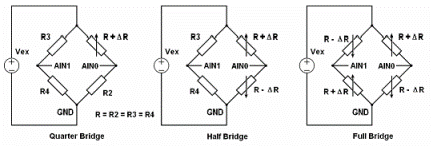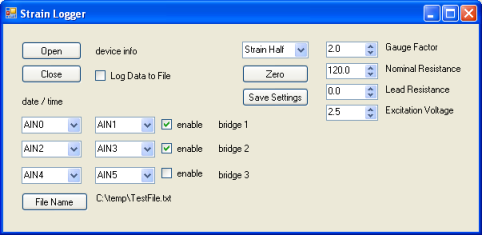C# Strain Logger and write to Spreadsheet file
This application note explains how to use a strain logger written in C#. It reads up to 3 bridges and writes the result to a text file that can be read by a spreadsheet program.
When an object is stretched due to an external force and the length of the object increases from L to L+ΔL, the ratio ΔL/L is called strain.
ε = ΔL/L
As the ratio of deformation is often very small, it is often represented in a units of 10-6 or μstrain
![]() A
strain gauge can be used to measure the strain of this object. The
most common type of strain gauge consists of a flexible backing which
supports a metallic foil pattern etched onto the backing. As the
object is deformed, the foil pattern is deformed, causing its
electrical resistance to change. This resistance change, usually
measured using a Wheatstone bridge circuit, can be used to calculate
the exact amount of deformation.
A
strain gauge can be used to measure the strain of this object. The
most common type of strain gauge consists of a flexible backing which
supports a metallic foil pattern etched onto the backing. As the
object is deformed, the foil pattern is deformed, causing its
electrical resistance to change. This resistance change, usually
measured using a Wheatstone bridge circuit, can be used to calculate
the exact amount of deformation.
The gauge factor of a strain gauge relates strain to change in electrical resistance. The gauge factor GF is defined by the formula

where RG is the resistance of the undeformed gauge, ΔR is the change in resistance caused by strain, and ε is strain. ΔR is typically in the region of 0.1%. To measure such small resistance changes, a Wheatstone bridge is employed. There are 3 configurations are used - quarter bridge, half bridge or full bridge. The strain adaptor allows for all these three configurations by plugging in the respective bridge completion resistors and then wiring up the strain gauges via the screw terminals. Excitation voltage of 2.5V is provided. Up to six input channels are available.

Quarter Bridge Strain Measurement
The quarter bridge equation is given
![]()
![]()
where VOFFSET is the offset voltage measured when there is no load and RL is the lead resistance.
Half Bridge Strain Measurement
The half bridge (bending) equation is
![]()
Full Bridge Strain Measurement
The full bridge (bending) equation is
![]()
Using the Strain Logger
The strain logger is written in Visual C# 2005. You can use the program as is or modify to suit your specific needs. To modify the program you may use the free Visual C# Express.
The program allows for
- up to 3 bridges of either quarter, half or full bridge configuration. The results are either in μV or μstrains.
- writes the results to a text file. It can be read by any spreadsheet since the results are tab delimited.
- results are time stamped.

To run the program
- Open Strain Logger VC2005 folder.
- Goto the WinLogger\bin\Debug folder
- Click on StrainLogger.exe to run the program.
- Configure the various parameters as required. The above configuration shows two bridges enabled. They are half bridge. Once bridge is connected to AIN0 and AIN1 and the other connected to AIN2 and AIN3. Click the Save button to save the settings.
- Click Open to start acquisition. The acquisition rate is fixed 1Hz.
- device info will changed to EMANT300 000001
- date/time will show the actual date and time and increments every second
- bridge 1 and bridge 2 will show the value measured in μstrains
- You may want to zero the offset voltage by clicking the Zero button. Click the Save button to save the setting.
- To log the data to file, click the Log Data to File checkbox. You must uncheck the box to stop logging and to save the file. The file name can be changed by clicking the File Name button.
- Click Close to stop the acquisition.